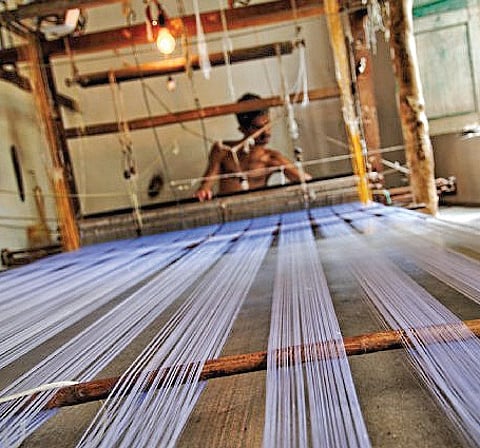

Khadi, which was used by Mahatma Gandhi as the symbol of freedom struggle infusing spirit of nationalism, was a powerful tool for self-reliance. The concept and history of Make in India, in fact, started with khadi. Ironically, the fabric of freedom has long lost its relevance except as a dress code for politicians.
The tide has seemingly turned for this handspun textile ever since Narendra Modi has taken over as Prime Minister. He has become the brand ambassador for khadi and has the fashionistas buzzing with approbation through his trademark kurtas and jackets. The PM has displayed his brand of nationalism with his unique personal dressing style both in India and abroad. Suddenly, there has been a surge in demand, made more heartening by the fact that the younger generation has taken to it as a fashion statement, beating the faux-simplicity or drumbeating patriotism by a few elite and the politicians.
Backed by Modi’s all-consuming debate over nationalism and Make in India campaign, the future of this sector is beginning to look bright with the NDA government’s plan to make its nearly 37 lakh employees wear khadi to the office at least once a week. Most are already acquiescent to this move and, if implemented, it can prove a catalyst in reviving khadi from the brink of oblivion.
The effort in this regard by the Khadi and Village Industries Commission (KVIC) is equally significant. In addition to this, the Railways, Air India, a few states, some public and private sector companies have also begun to popularise khadi.
Top designers and fashion retailers are also coming forward to link up with the product as well as its marketing.
Khadi, as a product, has the potential to reduce poverty in the country by providing sustainable self-employment to the poorest of the poor. It involves manual labour that does not require high skill-sets and can generate mass employment. There are around 13,000 khadi institutions with over 11 lakh spinners and weavers and nearly 7,000 outlets. In 2014-15, sale of khadi products was to the tune of `1,144 crore, which roughly comprises 1 per cent share of the entire textile market. While KVIC has planned to take the share up to 3.5 per cent in the next fiscal, the Centre aims at creating additional 19.5 lakh jobs in the sector.
What seems to be a tough challenge, however, is to translate the sloganeering to actual action on the ground, making spinning of the yarn a viable proposition for the person at the farthest mile. Khadi’s essence and authenticity lies in the handspun and hand-woven character and should not be confused with handloom that uses power for churning the yarn.
One of the major hindrances is low wages in the labour-intensive sector. A spinner gets a measly `4.50 as wage per hank (1,000 m roll), which needs to be urgently reviewed if this sector aims at quality product. Besides, khadi enterprises should be developed through SHG mode while strengthening the khadi institutions for raw material and marketing linkages. There is also a need for innovation and variety without tampering with the manual nature of khadi.
In promoting khadi, the government will achieve the twin objectives of job creation and poverty
alleviation along with infusing the common man with national pride, that the ‘fabric of freedom’ automatically embodies.
srimoy@newindianexpress.com
(Ravi Shankar is travelling)